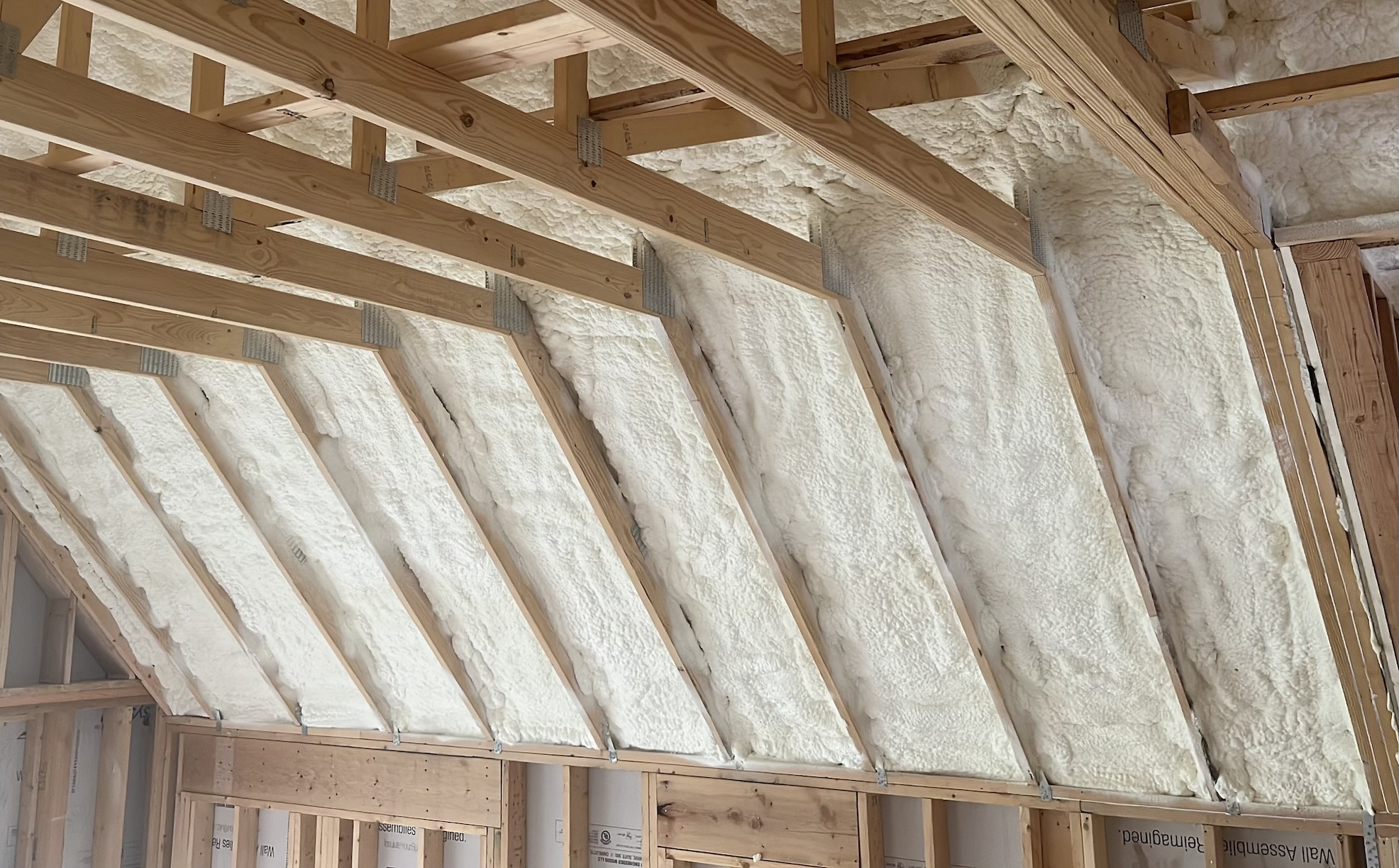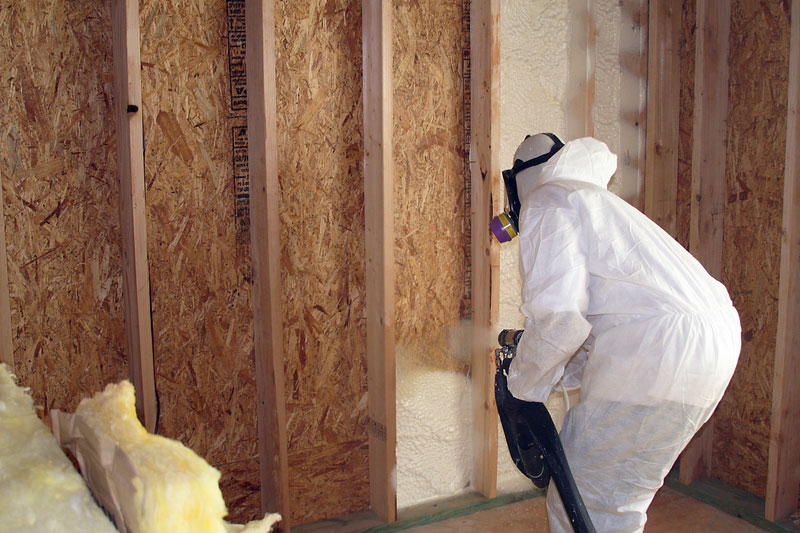Spray foam insulation reduces energy bills by creating an airtight thermal barrier that prevents conditioned air from escaping and outdoor air from entering your home. This superior air sealing capability can cut heating and cooling costs by 15-50%, with most homeowners seeing a 20-30% reduction in monthly energy expenses. The foam expands to fill gaps and cracks that traditional insulation misses, creating a continuous barrier that maintains consistent indoor temperatures year-round.
The energy savings come from spray foam’s dual action as both insulation and air sealant. Unlike fiberglass batts or loose-fill materials, spray foam adheres directly to surfaces and expands to eliminate thermal bridges and air leaks that account for up to 40% of energy loss in typical homes. This article provides detailed information about spray foam types, installation considerations, and long-term financial benefits to help you make an informed decision.
 Types of Spray Foam Insulation
Types of Spray Foam Insulation
Open-cell and closed-cell spray foam offer different benefits for energy efficiency. Open-cell foam costs less initially but provides lower R-values, while closed-cell foam delivers maximum thermal performance and structural benefits.
| Foam Type | R-Value per Inch | Cost per Board Foot | Best Applications | Air Sealing Rating |
| Open-Cell | 3.5-3.8 | $0.44-$0.65 | Interior walls, attics | Good |
| Closed-Cell | 6.0-7.0 | $1.00-$1.50 | Exterior walls, basements, rim joists | Excellent |
Bonus Tip: Closed-cell foam adds structural strength to walls while insulating, making it ideal for older homes that need both energy efficiency and reinforcement.
Open-Cell Spray Foam
Open-cell foam creates effective thermal barriers in interior applications where moisture control isn’t the primary concern. The foam’s softer texture allows for easier trimming and adjustment after installation, making it suitable for attic applications where access panels may be needed.
Closed-Cell Spray Foam
Closed-cell foam provides superior energy savings in exterior applications and below-grade installations. Its moisture resistance prevents humidity problems while delivering maximum R-value per inch, making it ideal for tight spaces where insulation thickness matters.
Energy Savings Breakdown
Understanding how spray foam reduces energy costs helps homeowners evaluate the investment potential. The thermal performance creates immediate savings that compound over time through reduced HVAC runtime and maintenance needs.
| Energy Loss Source | Percentage of Total Loss | Spray Foam Effectiveness |
| Air leaks | 25-40% | 95-99% reduction |
| Thermal bridging | 15-25% | 90-95% reduction |
| Conduction | 30-45% | 80-90% reduction |
| Infiltration | 10-20% | 98-100% reduction |
Market data shows that homes with spray foam insulation maintain more consistent temperatures, reducing HVAC cycling by up to 40%. This decreased equipment runtime extends system lifespan by 3-5 years on average, adding to long-term savings.

Installation Areas That Maximize Savings
Strategic placement of spray foam insulation targets the biggest energy loss sources in residential structures. Focusing on these key areas delivers the best return on investment.
Attic and Roof Deck
Attic insulation with spray foam eliminates stack effect and radiant heat transfer. Applying foam directly to the roof deck creates a conditioned attic space, protecting HVAC equipment and ductwork from temperature extremes.
Bonus Tip: Spray foam on the roof deck allows attic space to be used for storage or mechanical equipment without compromising energy efficiency.
Basement and Crawl Space
Foundation insulation with spray foam prevents ground moisture and temperature transfer. Closed-cell foam on basement walls eliminates condensation issues while creating warmer floors above.
Rim Joists and Band Boards
These areas represent significant thermal weak points in most homes. Spray foam application here stops air infiltration and prevents ice dams in cold climates.
Cost Analysis and Payback Period
Initial investment in spray foam insulation typically pays for itself through energy savings within 5-10 years. The payback period depends on local energy costs, climate zone, and existing insulation levels.
| Home Size | Installation Cost | Annual Savings | Payback Period |
| 1,500 sq ft | $4,500-$9,000 | $600-$900 | 5-8 years |
| 2,500 sq ft | $7,500-$15,000 | $900-$1,400 | 6-9 years |
| 3,500 sq ft | $10,500-$21,000 | $1,200-$1,800 | 7-10 years |
Energy costs continue rising annually, making spray foam’s fixed investment more valuable over time. Homes with spray foam also see increased resale values of 3-5% due to improved energy efficiency ratings.
Performance in Different Climate Zones
Spray foam insulation adapts to various climate conditions, providing energy savings in both heating and cooling dominated regions. The air sealing properties benefit all climates by maintaining consistent indoor conditions.
Cold Climates
In heating-dominated areas, spray foam prevents warm air escape and eliminates ice dam formation. The continuous thermal barrier reduces heating costs by 25-40% compared to traditional insulation.
Hot Climates
Cooling-dominated regions benefit from spray foam’s ability to block radiant heat transfer and maintain cool indoor temperatures. Proper installation reduces cooling costs by 20-35%.
Mixed Climates
Areas with both heating and cooling seasons see year-round benefits from spray foam’s consistent thermal performance. The investment pays dividends across all seasons.
Things to Consider Before Making a Decision
Several factors influence spray foam insulation’s effectiveness and cost-benefit ratio. Evaluate these considerations to determine if spray foam aligns with your home’s needs and budget.
Existing insulation condition affects removal costs and installation complexity. Homes with old or damaged insulation may need complete removal before spray foam application.
HVAC system sizing becomes important after spray foam installation. Improved efficiency may allow for smaller, less expensive replacement equipment when current systems fail.
Local building codes vary regarding spray foam types and installation requirements. Some areas mandate specific fire ratings or application methods.
Professional installation quality directly impacts performance and longevity. Choose certified contractors with documented spray foam experience and proper equipment.
Future renovations should be planned before spray foam installation. The foam bonds permanently to surfaces, making future modifications more challenging.
Common Questions About Spray Foam Energy Savings
How quickly do energy savings appear after installation? Energy savings begin immediately after spray foam cures, typically within 24-48 hours. Most homeowners notice reduced HVAC runtime and more consistent temperatures within the first week.
Does spray foam work equally well in all areas of the home? Different areas provide varying levels of energy savings. Attics and basements typically show the greatest impact, while interior walls provide comfort improvements but smaller energy reductions.
Can spray foam insulation reduce energy bills in older homes? Older homes often see the greatest percentage savings due to poor existing insulation and significant air leakage. Energy bill reductions of 30-50% are common in homes built before 1980.
Long-Term Performance Factors
Spray foam insulation maintains its energy-saving properties for decades when properly installed. The material doesn’t settle or degrade like traditional insulation, ensuring consistent performance throughout its lifespan.
Bonus Tip: Annual HVAC maintenance becomes even more important with spray foam insulation, as the improved building envelope puts less stress on equipment but requires proper system balance.
Spray Foam Insulation FAQ
What percentage of energy bills can spray foam insulation typically reduce? Most homeowners see 20-30% reductions in energy costs, with some achieving savings up to 50% depending on existing insulation quality and home construction type.
How long does spray foam insulation last before needing replacement? Properly installed spray foam lasts 80-100 years or more. The material doesn’t settle, shift, or degrade like traditional insulation materials, maintaining consistent performance throughout its lifespan.
Is spray foam insulation worth the higher upfront cost compared to other insulation types? The energy savings and air sealing benefits typically justify the higher initial investment within 5-10 years. Factor in improved comfort, reduced maintenance costs, and increased home value for complete financial analysis.
Can spray foam insulation help reduce noise transmission between rooms? Open-cell spray foam provides excellent sound dampening properties, reducing noise transfer between floors and rooms. Closed-cell foam offers moderate acoustic benefits while maximizing thermal performance.
Will spray foam insulation affect my home’s resale value? Homes with spray foam insulation often see increased market values of 3-5% due to improved energy efficiency ratings and lower operating costs that appeal to buyers.
Make the Right Decision
Residential Spray foam insulation offers proven energy savings through superior air sealing and thermal performance. The investment typically pays for itself within a decade while providing decades of continued savings and improved comfort.
Evaluate your current energy costs, existing insulation condition, and long-term home ownership plans when considering spray foam insulation. Consult with certified contractors to assess your specific situation and determine the most cost-effective application areas for your home.
Reviewer: Charlotte King reviewed this article based on her 7 years of spray foam experience, contributing thoughtful advice about building customer relationships and improving local visibility.









